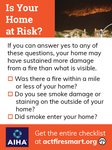

(NAPSI)—Wildfires are burning hotter and moving faster than ever before. They create health and safety hazards long after being extinguished. The residue and small particles carried in wildfire smoke breach homes’ external structures—settling into attics, ductwork, carpeting, wall cavities, furniture, bedding, mattresses and more. These particles can carry dangerous contaminates and toxic gases such as cyanides, acid gases and aldehydes including formaldehyde, causing asthma attacks, heart attacks, strokes and other health issues.
As parts of the country deal with active wildfires from extreme temperatures, homeowners returning to their homes may be unaware of the potential risks due to smoke damage and carcinogens left from wildfires.
Even if a structure is not burned, your home may have sustained more damage than what is visible. AIHA, the leading association for scientists and professionals committed to preserving and ensuring occupational and environmental health and safety in the workplace and community, offers free resources to help. AIHA’s Wildfire Disaster Recovery Center provides vital information on wildfire preparedness and recovery, and the hidden dangers in the cleanup processes that follow a devastating wildfire.
Potential health hazards during the cleanup and recovery phase can be avoided. As you return to your home, testing and property evaluation by a certified professional will ensure your family’s health and safety. If your home needs structural repairs or contamination removal, clearance testing is recommended prior to reconstruction and/or reentry.
Restoring your home to pre-fire conditions may involve more than carpet cleaning, removing the fire residue dusts or using ozone to eliminate fire-related odors (which could have lasting health effects, according to the EPA.)
Before clean up or repair, seek the advice of an OEHS expert. AIHA’s Wildfire Disaster Recovery Center provides additional information on wildfires, including hazards that may be present during and after a wildfire incident has occurred, contacts for certified professionals who can help with property evaluation and facts and figures to help people understand the scope of the challenges they face.
Note to Editors: While this article can be of interest to anyone, it’s particularly useful to people in Arizona, California, Florida, Georgia, Idaho, Montana, New Jersey, North Carolina, Oregon, Texas, Utah, Washington and Wyoming.